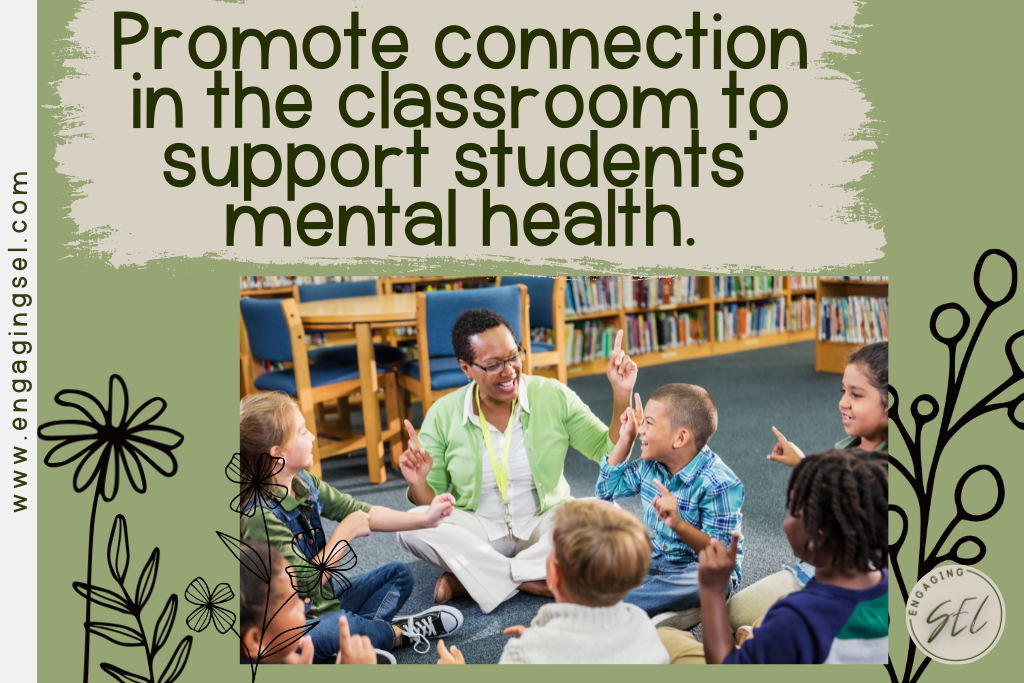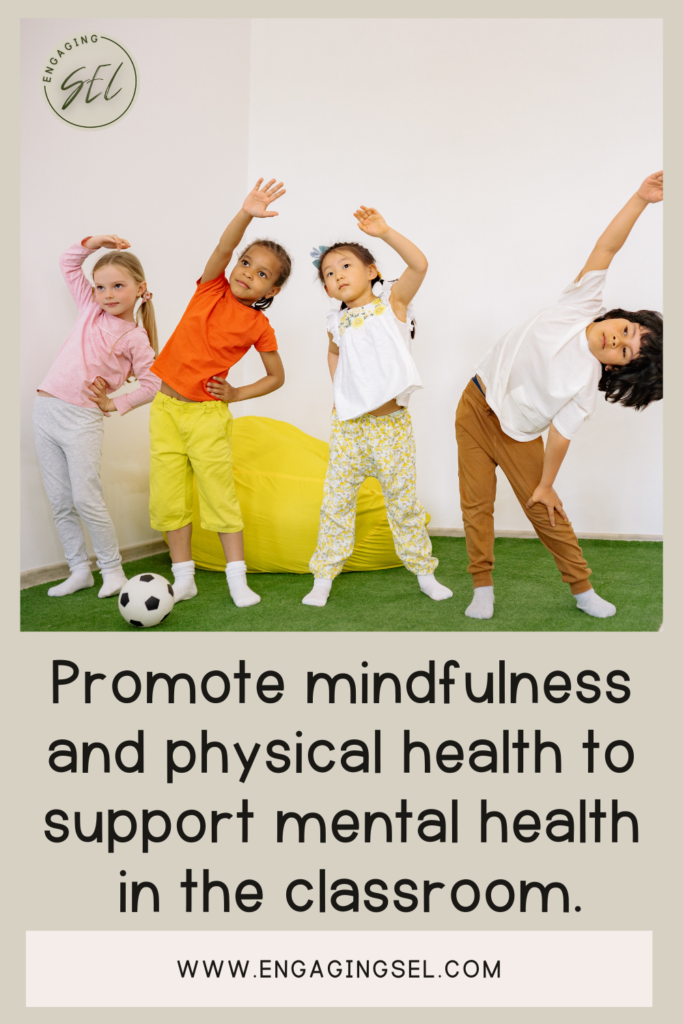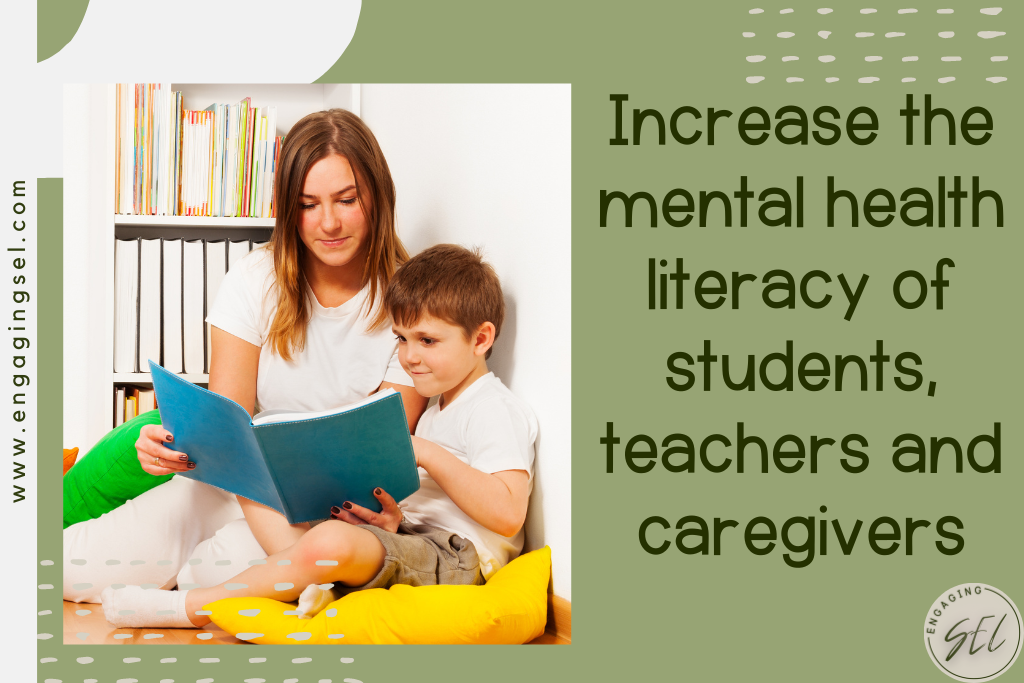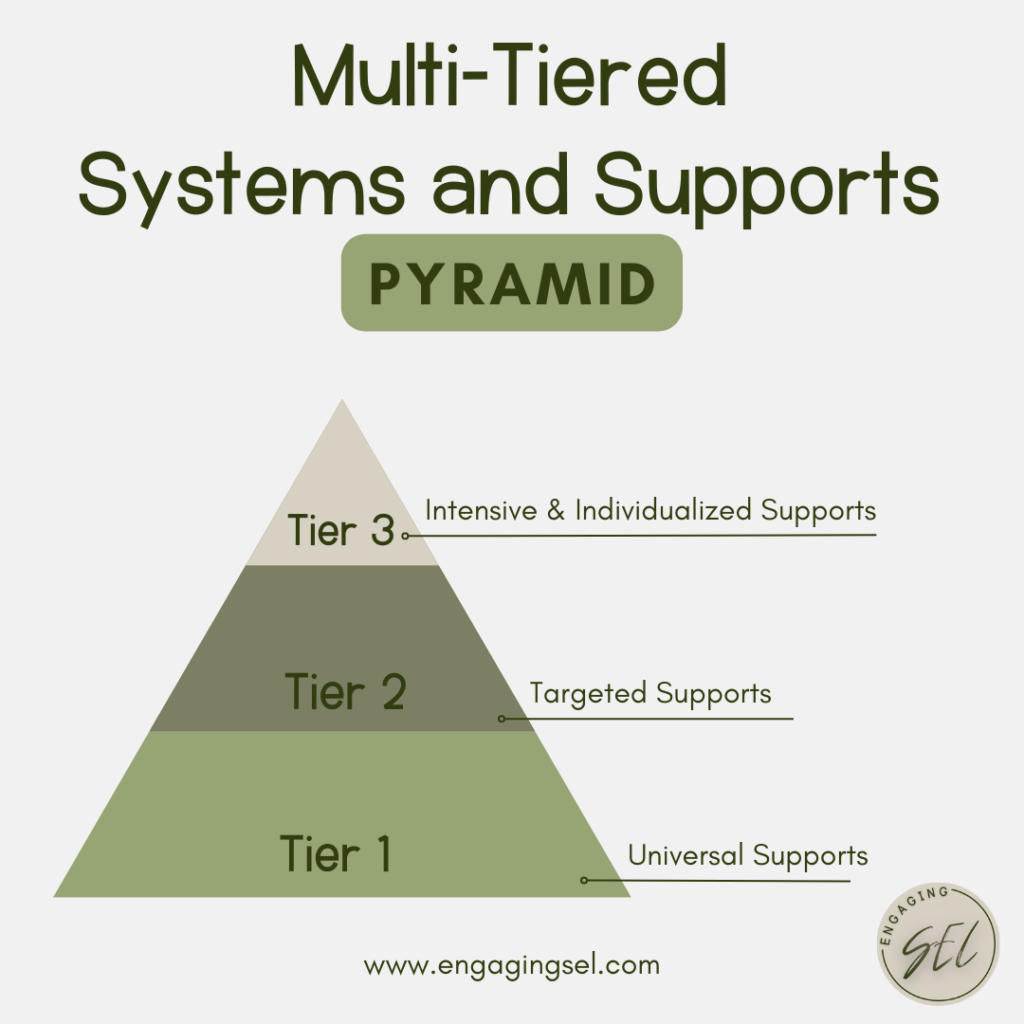As teachers, we are responsible for supporting students academically, teaching them the standards and what they need to know to move on to the next grade. But teaching the whole child means we are also responsible for the social, emotional, behavioral, and mental health of our students. We have so much on our plate that mental health can become an afterthought for us and our students. Mental health impacts students’ ability to learn, grow and succeed. Teachers must be intentional about supporting the mental health of the students in the classroom every day. October is mental health month so I have put together some simple strategies for you to implement in your classroom to support mental health for you and your students every day.
Promote Connection
Daily communication with others is a strong way to support the mental health of students in your classrooms. Allow students to connect with their peers daily. Classroom conversations are a great way to start the day. Morning meetings focused around a question of the day is an opportunity to give every student a voice and give the other students a chance to listen to their peers. Greet the students at the door with one comment for each student. It could be as simple as “ I am glad you are here today” or “I love your new dress.” Even a simple comment can make students feel seen and valued. It communicates to the students that you notice them and that you care.
Emotional check-ins are also a useful tool to take a temperature check on students’ mental health. This can be done at circle time for the younger students or at the beginning of a lesson, after transition for the older students. You can ask the students to give you a 1-5 with their fingers with 1 being the best and 5 being the worst. It is a quick way to gauge how students are feeling and you can check in with the students who are 3s, 4s, and 5s. You could even do a simple thumbs up, or thumbs down to see where the students are at and make a note to check in with the students who are thumbs down. I also like to display an emotions chart in my classroom seen here to help the younger students identify and label their emotions.

Break the Stigma
There is sometimes the fear of being labeled or judged for speaking up when students are asking about mental health or they might be struggling with something. The dialogue surrounding mental health has shifted in the past few years but the stigma surrounding mental health still exists. To combat this, teachers can create a culture of openness, compassion, and empathy in their classrooms. Teachers can start and encourage dialogue and discussions about mental health. Educators who provide emotional support and establish positive relationships influence children’s and students’ health, overall mental wellness, and life satisfaction (Stewart & Suldo, 2011).
Safe Spaces
Having a place in the room where students can do to take a break, regain control of themselves, and regulate their emotions is helpful to start creating a dialogue about mental health in the classroom. In my blog, The Power of a Classroom Calm-Down Space, I talk about all of the benefits of a calm-down area for students. If having a calm space somewhere in your classroom isn’t doable for you for whatever reason, make sure that there is a safe space for students to go somewhere in the school. This can be the school counselor’s office, another teacher’s classroom, or even the library. Students need to have a place to go where they feel safe, comfortable, and supported.
Share About Your Personal Experiences
If it is something you are comfortable with, opening up to your students about your struggles can create a safe, non-judgmental place for students to feel comfortable sharing. It doesn’t have to be your most private, deepest secrets but even just sharing your feelings and why you are feeling that way can make a huge difference. Students tend to put their teachers on a pedestal and think of them as perfect all the time. I share stories about my life with my students to show them that I am human and have the same feelings that they do. I tell my students all the time that I am in a bad mood because I didn’t sleep when my one-year-old cried all night. Or that I have a headache so I might be a bit grumpy today. It makes a huge difference in the overall climate and culture in the classroom. It also builds empathy because the students can relate to how I am feeling. They might try to be a bit quieter when I tell them I have a headache which is adorable. I have also overheard some comments like “ Didn’t you hear her say she didn’t sleep last night? Stop playing around.” Being open with your own emotions, experiences and mental health allows students the safe space to do so as well.
Provide Access to Mental Health Services
You might be limited as to what mental health services your school provides for students. Most schools at least will have a school counselor on site. Some schools may work with outside agencies to provide support to students during the regular school day. Regardless of the programs you have available to you, you can help students get connected to the resources they need. Being aware of the students in your care and paying attention to the signs and symptoms of stress and anxiety in students can help determine when students need to be connected to mental health support services.
Crisis Text Line ( Text HOME to 741741 to be connected to a Crisis Counselor) is a crisis intervention tool that you can provide to your students. Crisis Text Line also lists signs of stress and anxiety in youth as
- Bad dreams
- easily/constantly alarmed or startled
- Excessively tired/fatigued
- Absent or not wanting to go to class
- Hard time resting or sleeping
- Constant state of worry/concern
- Inability to concentrate or relax
- Complaining of stomach aches or physical pain
- Clingy behavior, becoming irritable
Being in close contact with parents and guardians about the home lives of students is an effective strategy to support the mental health of students in the classroom. Being aware of any potential issues that are going on in students’ home lives can help you monitor those students and be on the lookout for any changes in their mood, behavior, or performance in the classroom. Early intervention is key when dealing with getting students the support they need. Open and frequent communication with the adults in the students’ lives is a way to create a strong safety net of trusted adults in a student’s life.
Promote Mindfulness and Wellness Programs
Teachers might be limited to which mindfulness or wellness programs might be offered at their school. Some schools might not even have any programs in place but that’s okay! Teachers can implement several different strategies in their classrooms to support the overall wellness of their students.

Physical Health
Apart from the regular physical education curriculum offered at your school, students need multiple opportunities throughout the day to move and be active. Movement breaks are quick and easy ways to get students active in the classroom. I love to do a quick yoga flow, exercise video, or dance break as a transition between activities. It gives kids a chance to reset, get some of their wiggles out, and get that oxygen flowing to their brains. It helps them stay more focused on the upcoming lesson and promotes physical wellness in the classrooms.
Mindfulness
I love love, love doing daily mindfulness in the classroom with my students. Teaching breathing exercises and guided meditation exercises to my students has transformed the climate and culture in my classroom. Check out my blog post about Mindfulness in the Classroom to read more about how I do this. A focus on mindfulness helps students feel calmer, supports emotional awareness, helps students build resilience, and supports their stress management skills. Incorporating mindfulness breaks at various times throughout the day is a great way to help students refocus, find calm, and learn how to practice self-care when things get challenging for them. Get my free 7-step Guide to a Mindful Classroom to start your mindfulness practice with tour students today.
Enhance Mental Health Literacy
Mental health literacy is defined as “knowledge about mental health disorders that are associated with their recognition, management, and prevention” (Furnham & Swami, 2018, p.1). Increasing the awareness of mental health disorders and the importance of mental health is a step in removing the stigma and barriers to mental health support that many people face. Teachers can model understanding and appreciation for mental health and mental health challenges for their students. Model addressing challenges to reduce the stigma and increase supportive discussions surrounding mental health. This can be done at an age-appropriate level for all students.

Create opportunities in the classroom to discuss aspects of mental health, using mentor texts and age-appropriate materials to address these topics. The Trauma Educational Responsive Practices shares 30 lessons about mental health for free to get you started with introducing mental health to students. Phyllis Fagell recommends teaching students emotional literacy while still instructing in the content areas. For example, discussing the feelings and emotions of a character in a book during reading block or discussing the body’s response to stress during science. Building emotional literacy helps students understand emotions, name emotions and understand the emotions of others.
Work with the school counselor in your building to create opportunities to have school-wide or classroom discussions about mental health topics during the school day. Work with your administrators to invite community partners or educational programs to come to your school to speak with students about their mental health. Showing students that taking care of their mental health is just as important as taking care of their physical health will set the tone for students’ views about their mental health.
Evidence-Based Prevention Practices
Many schools use a framework called MTSS which stands for Multi-Tiered Systems of Support. This is a framework for organizing a continuum of evidence-based practices to support each student’s educational, social, emotional, and behavioral needs (https://mtss.org/overview/ ). Primary prevention (Tier 1) supports should be used school-wide as universal support for all students. These inventions can look like this:
- Creating a welcoming physical environment
- Intentionally connecting with students
- Consistent and predictable routines
- Explicitly teaching and reinforcing positive expectations
- Effective, engaging, culturally-relevant instruction
- Screening tools to plan, implement and assess instruction
- Specific and supportive feedback

These primary supports are things that all students should receive at all times, every day. Tier 2 supports are more intensive supports for students with more social, emotional, or behavioral needs. These supports could look like a Check-In Check Out plan, more opportunities for connection and feedback, or social skills groups. Tier 3 supports are intensive individualized supports for students who have a high-intensity social, emotional, or behavioral need.
I encourage you to work with your school, school counselor, or PBIS (Positive Behavioral Interventions and Supports) team to discuss what this framework might look like at your school or what Tier 1,2, and 3 supports you can implement for your students.
Build a Supportive Community
A supportive community is a safety net for students to help them feel connected and valued. Parents are the first line of defense for students. Schools should make every effort to include parents as part of the student’s supportive community. Schools can host workshops, and afterschool events and connect with community partners to educate parents about mental health conditions, and signs of distress in youth.
Teachers are the next part of the supportive community for students. Making the educational environment a safe, supportive space for students is critical for supporting their mental health. Teachers can implement strategies to build their classroom community such as:
- connection circles
- restorative practices
- morning meetings
- frequent opportunities for students to communicate with their peers
- Partner and group work to support collaboration and communication
- Check-in/ check-out
- Temperature checks
Peer support groups, extracurricular activities, and social events can all help to strengthen the relationships students have. Strong relationships can help reduce feelings of isolation and contribute to the overall positive atmosphere for students. Creating a unified support team dedicated to students’ emotional well-being is important to supporting students’ mental health as well. Use whatever resources you have available to you at your school to create this team.
Conclusion
Mental Health is everyone’s responsibility and there are simple things you can do in the classroom to create a positive space to nurture and support the mental health of the students in your classroom. I hope that you can use some of the ideas in this blog post in your classroom. October is Mental Health Month so this is a great time to share these tips with your team at your school and rethink and implement mental health support for every student in every class.
Mindfully yours,
Alyssa from Engaging SEL
Sources
Stewart, T., & Suldo, S. (2011). Relationships between social support sources and early adolescents’ mental health: The moderating effect of student achievement level. Psychology in the Schools, 48(10), 1016–1033. https://doi.org/10.1002/pits.20607
Trauma Educational Responsive Practices https://www.trepeducator.org/
U.S. Department of Education


